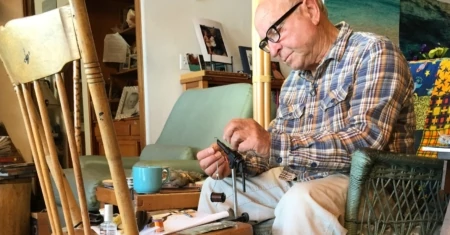One Fly, Many Lessons
Why Fish A Single Pattern All Year? Insight (And a Lot of Fish)
Modern-day fly fishing, like much in life, has become exceedingly complex, with high-tech gear and a confusing array of flies and terminal tackle. The newly revised second edition of our book Simple Fly Fishing, written by Patagonia founder Yvon Chouinard and fishermen Craig Mathews and Mauro Mazzo, reveals that the best way to catch trout is simply—with a rod, a fly and not much else. The wisdom in this book comes from a simpler time, when the premise was the more you know, the less you need. With paintings by renowned artist James Prosek, technical illustrations and inspiring photographs and stories throughout, the book reveals the secrets and the soul of this captivating sport.
Proceeds from this book are donated to various conservation and environmental organizations, including 1% for the Planet, Native Fish Society, Atlantic Salmon Federation, and World Trout Initiative. To contribute to the cause, you can find Simple Fly Fishing for purchase on Patagonia.com.
Wet your feet with an excerpt from Simple Fly Fishing below.
In the various outdoor pursuits and crafts that I’ve been involved in—from mountaineering and whitewater kayaking to spear fishing and tool making—the progression from novice to master has always been a journey from the complex to the simple. An illustrator becomes an artist when he can convey his message with fewer brush strokes.
Fishing with a fly seems to have gone in the opposite direction: It has become a needlessly complex and expensive pastime where anglers choose from hundreds of fly lines, high-tech rods and trout reels with drags that can stop a truck. We all know that palming the rim of a reel with a simple click drag can stop any trout or salmon, but the industry has become dependent on building insecurity in the minds of their customers—if we aren’t outfitted with the latest gear and au courant signature fly, can we really be enjoying ourselves? (I must admit that I too have multiple rods and reels and I’ve caught myself cursing for not having the exact fly for that specific stage of that particular mayfly.)
More than 30 years ago, I was introduced to the original method of fishing with a fly that was first described in the second century A.D. by Claudius Aelianus. This form of fishing is still practiced in parts of Spain, Italy and Japan, in addition to places where people cannot afford modern gear. I’ve adapted this simple tenkara style to the large rivers of North America with great success. The combination of the tenkara rod and soft-hackle wet flies (spiders) has proven for me to be the most effective way to catch trout on a fly.
I used to fish soft-hackles as part of a brace of different flies. Then I started noticing that most of time, the fish took the Pheasant Tail & Partridge fly. If that was so, why bother with the other patterns? Why not see how far I could go fishing an entire season with only that one style of fly?
Like most “new” ideas in fishing, this one had been thought of before. Arthur Wood, the advocate of greased line fishing for salmon, used only a March Brown for a whole season and a Blue Charm for another. He caught just as many salmon and, in fact, found his success with either fly was hardly different. Art Flick, the Catskill angler and fly tyer who wrote Streamside Guide to Naturals and Their Imitations, ended up using mostly one fly, the Grey Fox Variant. Jim Teeny has used only the Teeny Nymph since 1971. Some of the most successful salmon fishermen in Canada use only the Muddler Minnow, and there are steelheaders who only use a Skunk. My scheme was to use only the Pheasant Tail & Partridge style of fly for all trout, salmon and saltwater fish.
Years ago, the American angler George LaBranche considered the myriad aspects of using dry flies to catch trout, and he ranked their importance. The position of the fly on the water he ranked first. Second, the action of the fly. Third, the size of the fly. Fourth and fifth, the form and color of the fly. For the way I typically fish with wet flies, I rank the fly’s action as most important, followed by size and then presentation. I believe most fly fishers place too much importance on form and color.
The Pheasant Tail & Partridge (P.T.) is a neutral fly that fairly imitates most mayflies and caddis. It probably has its roots in the time of Dame Juliana Berners in 1496 when she wrote a treatise describing the wet-fly patterns used in England at that time. Frank Sawyer, the river keeper of the Avon, has been attributed as the developer of the modern day Pheasant Tail Nymph. Some years before, George Skues was already tying a version of the Pheasant Tail Soft Hackle.
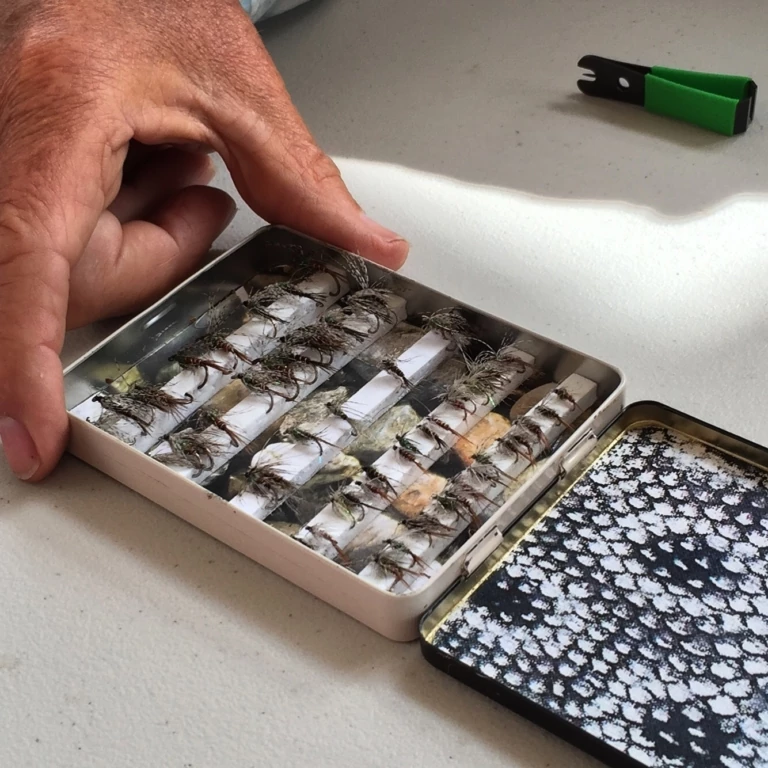
Classic Italian cooking uses only five perfect ingredients, and the Pheasant Tail & Partridge is equally simple. Photo: Chris Gaggia
My one-fly season began in the winter/spring of 2015 when I used the P.T. on the flats of both the Bahamas and Cuba. Bonefish that have been fished heavily can get very spooky. If they “blow up” when you strip the fly, it’s probably because they have seen too many shiny hooks, bright eyes and Flashabou.
I tied my saltwater P.T.s on size 6 and 8 weighted bronze hooks. I used long hackles from the backs of grouse necks and tied on two at a time to give a bushier look. With a small strip, the hackles pulsate like a jellyfish or shrimp. This plain brown fly rarely spooked wary bones, and even worked well over sand bottoms where you would normally use a light-colored fly. I’ve since used the P.T. for many other saltwater fish.
Fishing for trout in the spring and summer in Wyoming, Montana and Idaho, I fished a size 10 P.T. as an attractor. When a hatch came on, I switched to a more appropriate size. Regardless of the color of the naturals, or whether they were mayflies, caddis or stoneflies, the P.T. in the proper size outfished the more exact imitations.
My basic wet-fly technique is quite simple. I cast 45 degrees downstream and mend the line to slow down the swing. When the line starts to straighten, I slowly lift the rod up to straighten it even more. Once the line is straight, I give an occasional twitch with the tip of the rod. I’m trying to imitate an emerging caddis or mayfly swimming to the surface or struggling from its shuck. Nine out of ten times the take is right after the twitch.
The flexible tip of the tenkara rod is perfect for imparting this subtle action. I’ve found that a proper twitch is the most difficult thing to master in swinging wet flies—almost everyone overdoes it. A big twitch sends a wave of slack down the line, giving time for the fish to eject the fly.
Remember, you are trying to entice a take, not scare the fish. If you’re getting bites but few hook-ups, it’s either small fish or there’s slack in the line.
Modern fast- and medium-action rods are not designed to impart movement to the fly, they’re built to cast heavy flies a long distance—usually farther than the fish. Add the typical 5- or 6-weight line, and the line droop at the end of the rod prevents any sort of twitch from transferring to the fly. The best you can do is lower the tip to the water and try to give the smallest hand strip. When I want to use a rod and reel, I use a cane rod or a 10-foot 2-weight rod with a 1-weight line to avoid the line droop. I also tie knotted leaders because the increased water friction helps straighten the line.
When fishing a brace of flies, I tie the larger fly on the point and the smaller on the dropper, keeping them about 30 inches apart. The two-fly system increases the friction and gives different action to each fly. I can’t emphasize enough the importance of giving action to the fly. Like your house cat, fish are predators. Slowly pull a toy mouse across the floor and the cat will go into its predator stance. Stop pulling and give it a twitch—the cat pounces. Grizzly bears and tigers love it when you run.
The tenkara wet-fly method is very simple, but like classic Italian cooking, which uses no more than five ingredients, each ingredient must be perfect in order to achieve excellence. Of course, you don’t need to be a master to catch fish. I’ve been using tenkara to teach 8- to 12-year-olds to fish, and after only a 10-minute lesson they are onto the first fish of their lives. But I’ve also learned some subtle fish-teasing moves that I can’t begin to describe. It would be like trying to communicate how to crack a safe.
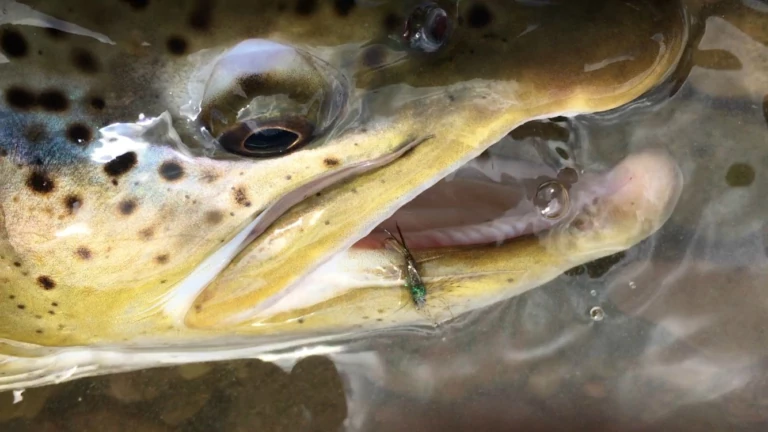
For trout, a subtle twitching during the swing imitates many types of emerging insects. Photo: Katsumi Fujikura
In early July, I applied my one-fly approach to the salmon of the Hawke River in Labrador. I tied the P.T.s on size 10 and 12 low-water salmon hooks and fished them mostly with a Portland hitch on the surface. In a week I landed about 20 proper salmon and a few grilse.
Later, on the Haffjardara in Iceland I had similar luck. Most of the fish were grilse, and I used a 10-foot 5-weight rod that allowed for more sensitivity in giving action to the fly.
The occasional twitch with the hitched fly was especially effective at inducing takes in slower water. I wasn’t trying to prove a point anymore; it was simply the most effective way to catch these salmon. I’ve since taken to hitching the P.T. for trout, which often leads to explosive takes.
In September, I had an opportunity to fish steelhead for five days on the Babine River in British Columbia. The first day was a bust, with only six inches of visibility. It cleared to a foot on the second day, but I had no confidence that a fish would be able to see my small flies. I put on a sink-tip line with a big dark Intruder and caught one small steelhead.
On the third day, I still couldn’t see my boots but the water was clearer and the parr were active in the shallow riffles, feeding on caddis and Green Drakes in the afternoon. I thought if the parr could see the tiny naturals, then surely the adults could see my size 10 P.T. Sure enough, I started catching some large steelhead. I even caught two sockeye salmon, which is very unusual so late in the season, and so far from the sea.
Conditions continued to improve, and I switched to a floating line and a Portland-hitched P.T. Even fishing behind other anglers who were throwing traditional, gaudy steelhead flies, the P.T. produced fish up to 37 inches.
Many times when using large waking flies for steelhead you get boils, but no takes. I believe this is because the flies are too large. Rarely do I get only a boil with the small flies. In this situation, I’m convinced it was the most effective fly and technique I could have used.
We think anadromous fish take flies because it’s a memory from when they were parr and eating insects. If that’s so, it would explain why a small fly works so well, especially when there’s a hatch. We humans think of ourselves as perpetual teenagers. Maybe salmon and steelhead do too?
In the late fall and through the winter, when the only hatches are tiny midges and Blue-Winged Olives, most anglers stoop to throwing streamers and rubber-legged and plastic concoctions—outfits for a Barbie doll, as Tom McGuane calls them. But both midges and BWOs are active swimmers, and a size 20 or 22 sparsely tied P.T. fished on the surface with a tiny twitch can be as effective as any other fly.
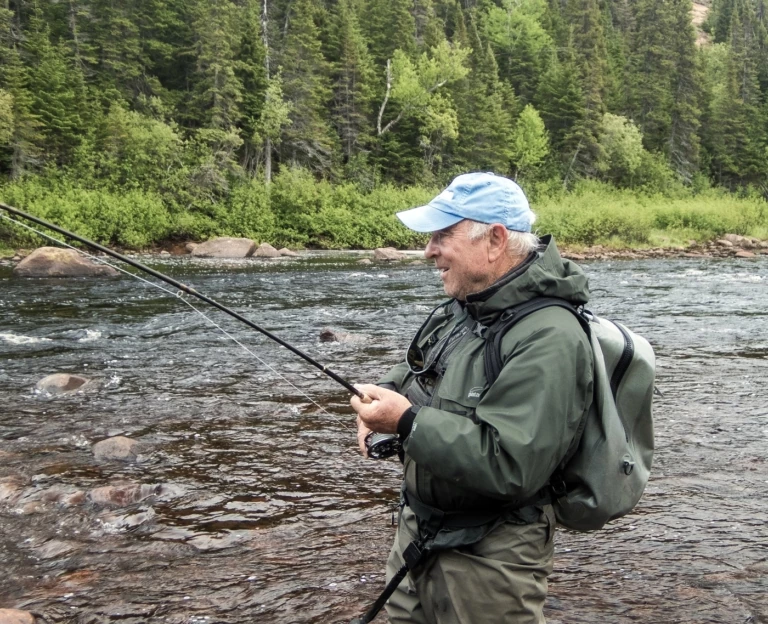
By choosing to fish with a fly, you set limits for yourself. Choosing to fish with only one style of fly helps you focus on becoming a better fly fisher instead of a gear hound. Photo: Mauro Mazzo
Am I going to continue using only one fly for the rest of my life? My tying table looks pretty brown and boring, and I feel the lessons have already been learned. Action and size are more important than style and color. I’m much more confident in using small flies. Look at how many large salmon have been fooled by a size 16 Madeline—a fly dressed with only five bear hairs that doesn’t imitate anything except lint. The fish see everything in their window, but that doesn’t mean they care a whit whether your mayfly is tied with three tails or two.
Since I first drafted this article I’ve been wondering how I could go searching for “deep knowledge” about the Muddler Minnow. Maybe tie up some tiny ones to imitate caddis; large ones on dry-fly hooks for hopper season; weighted to pass for sculpins, minnows and gobies. Tie some on low-water salmon hooks for salmon and steelhead, and maybe even a big-ass one for tarpon or whatever!
Limiting options forces creativity. Fishing for a year with only the Pheasant Tail & Partridge has given me deep knowledge about what to do with that simple brown fly, and a deeper understanding of fish. It has taught me that choosing a more simple life doesn’t mean choosing an impoverished life. Rather, simplicity can lead to a more satisfying way of fishing and a more responsible way of living.
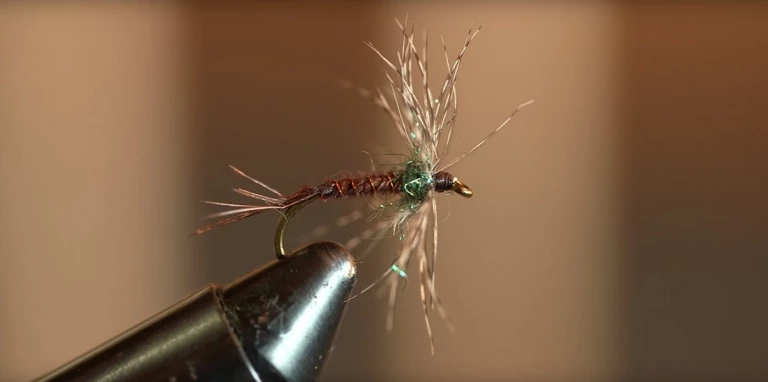
Pheasant Tail & Partridge tied by Yvon Chouinard. Photo: Chris Gaggia
Pheasant Tail & Partridge
Hook: Dai-Riki #075 or Tiemco 3769 (1X short, 2X heavy)
Thread: Dark brown
Rib: Copper wire
Tail: Pheasant tail fibers
Abdomen: Pheasant tail fibers
Hackle: Hungarian partridge
Thorax: Peacock Hareline Ice Dub
Tying Notes:
- The #075 Dai-Riki and Tiemco 3769 are similar hooks that both sink a bit at first and can better imitate a rising emerger. They are also shorter, so a size #12 is more like a #14.
- Counterwind the copper wire for a more durable abdomen.
- Wrap the hackle 1.5 to 2 turns. Try to find a neck from an older bird shot later in the season so the feathers will be more stiff and durable.
- The thorax is tied last. Push it up against the hackle, keeping it from pressing flat against the body.
- When wet, the thorax looks a lot like the air bubble of an emerging fly. It’s an important improvement over normal soft-hackle flies.
- To tie a P.T. dry fly, just use a dry-fly hook. To tie a nymph, add a black tungsten bead in front of the hackle.
This story first appeared in Fly Fisherman and Trout & Salmon magazines.
